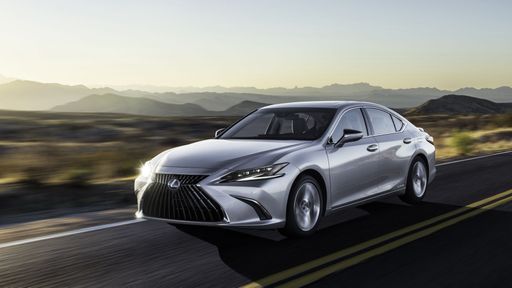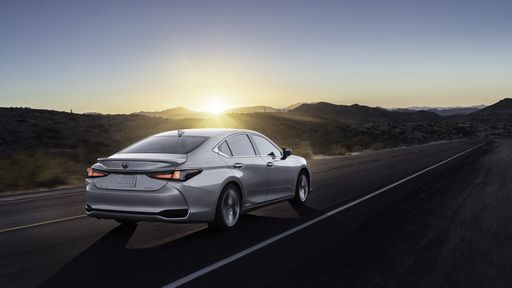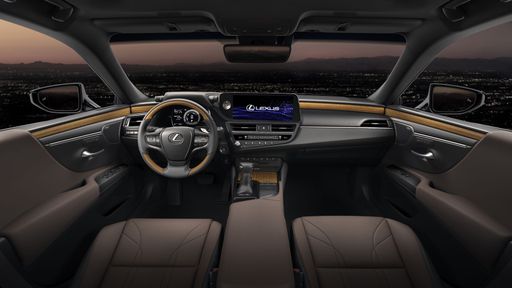Lexus ES VS Vauxhall Vivaro – Specs, Efficiency & Price Comparison
Which model is the better choice – the Lexus ES or the Vauxhall Vivaro? We compare performance (218 HP vs 177 HP), boot capacity (454 L vs ), efficiency (5.10 L vs 23.60 kWh6.60 L), and of course, the price (46600 £ vs 31000 £).
Find out now which car fits your needs better!
The Lexus ES (Sedan) is powered by a Full Hybrid engine and comes with a Automatic transmission. In comparison, the Vauxhall Vivaro (Cargo Van) features a Diesel or Electric engine and a Manuel or Automatic gearbox.
When it comes to boot capacity, the Lexus ES offers 454 L, while the Vauxhall Vivaro provides – depending on what matters most to you. If you’re looking for more power, you’ll need to decide whether the 218 HP of the Lexus ES or the 177 HP of the Vauxhall Vivaro suits your needs better.
There are also differences in efficiency: 5.10 L vs 23.60 kWh6.60 L. In terms of price, the Lexus ES starts at 46600 £, while the Vauxhall Vivaro is available from 31000 £.
Compare all the key specs now and find out which model fits your lifestyle best!
Lexus ES
The Lexus ES represents a blend of luxury and comfort, offering a smooth driving experience that is characteristic of the brand. With its elegant design and meticulously crafted interior, it provides a serene environment for both driver and passengers. The inclusion of advanced safety features and cutting-edge technology enhances its appeal, ensuring that every journey is not only enjoyable but also secure.
details @ toyota-media.de
@ toyota-media.de
 @ toyota-media.de
@ toyota-media.de
 @ toyota-media.de
@ toyota-media.de
Vauxhall Vivaro
The Opel Vivaro is a versatile van that excels in both practicality and comfort, making it a popular choice for businesses and families alike. Its sleek design is complemented by a spacious interior, providing ample room for passengers or cargo. With a focus on durability and performance, this vehicle is well-suited for long journeys and demanding workloads.
details

|
|
|
|
|
Costs and Consumption |
|
|---|---|
|
Price
46600 - 59300 £
|
Price
31000 - 52500 £
|
|
Consumption L/100km
5.10 L
|
Consumption L/100km
6.6 - 7.7 L
|
|
Consumption kWh/100km
-
|
Consumption kWh/100km
23.6 - 24 kWh
|
|
Electric Range
-
|
Electric Range
221 - 352 km
|
|
Battery Capacity
-
|
Battery Capacity
-
|
|
co2
115 g/km
|
co2
0 - 194 g/km
|
|
Fuel tank capacity
50 L
|
Fuel tank capacity
69 L
|
Dimensions and Body |
|
|---|---|
|
Body Type
Sedan
|
Body Type
Cargo Van
|
|
Seats
5
|
Seats
3 - 6
|
|
Doors
4
|
Doors
4
|
|
Curb weight
1680 kg
|
Curb weight
1722 - 2260 kg
|
|
Trunk capacity
454 L
|
Trunk capacity
-
|
|
Length
4975 mm
|
Length
4980 - 5330 mm
|
|
Width
1865 mm
|
Width
1920 mm
|
|
Height
1445 mm
|
Height
1895 - 1935 mm
|
|
Payload
470 kg
|
Payload
840 - 1270 kg
|
Engine and Performance |
|
|---|---|
|
Engine Type
Full Hybrid
|
Engine Type
Diesel, Electric
|
|
Transmission
Automatic
|
Transmission
Manuel, Automatic
|
|
Transmission Detail
-
|
Transmission Detail
Schaltgetriebe, Automatikgetriebe
|
|
Drive Type
Front-Wheel Drive
|
Drive Type
Front-Wheel Drive
|
|
Power HP
218 HP
|
Power HP
120 - 177 HP
|
|
Acceleration 0-100km/h
8.90 s
|
Acceleration 0-100km/h
10.5 - 14.3 s
|
|
Max Speed
180 km/h
|
Max Speed
130 - 185 km/h
|
|
Torque
-
|
Torque
260 - 400 Nm
|
|
Number of Cylinders
4
|
Number of Cylinders
4
|
|
Power kW
160 kW
|
Power kW
88 - 130 kW
|
|
Engine capacity
2487 cm3
|
Engine capacity
1499 - 1997 cm3
|
General |
|
|---|---|
|
Model Year
2024
|
Model Year
2024 - 2025
|
|
CO2 Efficiency Class
C
|
CO2 Efficiency Class
G, F, A
|
|
Brand
Lexus
|
Brand
Vauxhall
|
Lexus ES
Explore the Alluring Elegance of the Lexus ES
The Lexus ES continues to uphold its reputation as a beacon of luxury and innovation in the automotive world. Known for its graceful design and premium feel, the ES series offers an impressive blend of performance and efficiency. With a focus on technical prowess and sustainability, this model is a testament to Lexus's commitment to excellence.
Performance and Efficiency: A Seamless Blend
At the heart of the Lexus ES is its full-hybrid technology. The 218 PS powertrain, featuring a 4-cylinder engine, harmoniously integrates a combustion engine with an electric motor to provide a remarkable drive. The ES achieves its impressive power output of 160 kW while maintaining a commendable fuel consumption of 5.1 L/100 km. This balance between power and efficiency is manifested in its acceleration from 0 to 100 km/h in just 8.9 seconds, powering seamlessly through a cost-effective CVT-gearbox with front-wheel drive. Despite its athletic capabilities, the ES remains well within the bounds of responsible emissions with a CO2 output rated at 115 g/km.
Design and Comfort: A Statement of Luxury
The Lexus ES's exterior is crafted as a testament to sophistication. Its sleek silhouette measures 4975 mm in length, 1865 mm in width, and 1445 mm in height, with a striking aesthetics that demands attention. The interior offers spacious comfort with seating for five, highlighted by high-quality materials and meticulous attention to detail. Additionally, the boot space offers a generous 454 litres capacity, ensuring practicality is not compromised.
Technological Advancements and Features
Equipped with the latest in automotive technology, the Lexus ES features a suite of advanced driver-assistance systems for enhanced safety and convenience. From its responsive infotainment system to the intuitive controls, each feature has been designed with the driver in mind. For those seeking variety, the car is available in several trim levels including the Automatik, Business Edition Automatik, Executive Automatik, and Luxury Automatik, offering a tailored experience for every discerning driver.
Cost of Ownership
With prices ranging from €54,350 to €69,200, the Lexus ES provides a competitive edge in the luxury segment with its multitude of features. The running costs are also reasonable, with expense estimates ranging from €1,289 to €1,497 per month and a cost per kilometre between 51.6 and 59.9 cents. This cost efficiency makes it a feasible choice for those looking to balance luxury with practicality.
Conclusion: A Hybrid of Innovation and Style
The Lexus ES stands as a prime example of how hybrid technology can transform the driving experience, merging the thrill of performance with the benefits of fuel efficiency. With its state-of-the-art features and impeccable build, the ES is a remarkable vehicle for those who seek luxury and innovation on the road.
Vauxhall Vivaro
Introducing the Opel Vivaro: Versatile & Efficient Transport Companion
The Opel Vivaro, a popular choice among transport professionals, combines practicality with innovative technology. As a versatile vehicle designed for utility and efficiency, the Vivaro aligns with the needs of businesses and individuals looking for reliable transport solutions.
Performance & Powertrain Options
The Opel Vivaro offers a variety of engine configurations, ranging from economical diesel variants to cutting-edge electric options. The diesel engines, available with power outputs between 120 and 177 PS, feature either a manual or automatic transmission and are built for both performance and economy, showcasing a fuel consumption range of 6.6 to 7.7 L/100km.
For those seeking a more sustainable option, the electric version of the Vivaro provides an impressive range of 212 to 351 km on a single charge, with energy consumption between 23.6 and 24.8 kWh/100km, making it an environmentally-friendly choice for businesses looking to reduce their carbon footprint.
Interior & Comfort
Inside the Vivaro, comfort meets practicality. With seating for up to six passengers, the vehicle offers a spacious cabin equipped with modern amenities. The layout is designed to enhance driver comfort and reduce fatigue on longer journeys, which is especially beneficial for delivery drivers and professionals consistently on the road.
Innovative Technology
Opel has integrated advanced technological features into the Vivaro, optimising both the driving experience and safety. Driver assistance technologies, such as adaptive cruise control and lane assist, enhance safety by supporting the driver in various situations. Additionally, the Vivaro includes a range of infotainment options to ensure connectivity and entertainment on the go.
Practicality & Load Capacity
The Opel Vivaro is a transporter by design, and its cargo capacity aligns with this purpose. Offering a sizeable cargo area, with a length ranging from 4959 to 5309 mm, the Vivaro supports a payload capacity between 912 and 1333 kg, making it ideal for businesses that require extensive space for goods and equipment.
Economy & Environmental Considerations
Each engine option in the Vivaro line-up is designed with economy in mind. The diesel variants are equipped with fuel-saving technologies, while the electric models contribute to zero emissions during operation, earning top marks in CO2 efficiency. Efficient fuel and energy consumption ratings enhance both the economic and environmental appeal of the Vivaro.
Conclusion
The Opel Vivaro stands out as a robust and versatile vehicle for businesses, offering a balance of power, efficiency, and advanced technology. Whether selecting from the reliable diesel models or the innovative electric versions, the Vivaro meets the demands of modern transport with style and substance, making it a valuable asset for any fleet.
The prices and data displayed are estimates based on German list prices and may vary by country. This information is not legally binding.
